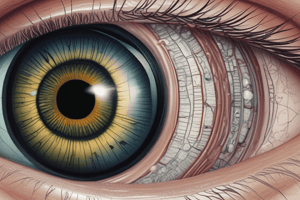Podcast
Questions and Answers
The cornea receives most of its oxygen from internal sources like blood supply.
The cornea receives most of its oxygen from internal sources like blood supply.
False (B)
The corneal endothelium enables direct diffusion of gases into the cornea from the surrounding air.
The corneal endothelium enables direct diffusion of gases into the cornea from the surrounding air.
True (A)
Tears do not play a role in providing oxygen to the cornea.
Tears do not play a role in providing oxygen to the cornea.
False (B)
Corneal swelling can enhance oxygen permeability.
Corneal swelling can enhance oxygen permeability.
Alteration in the tear film covering the corneal surface has no impact on oxygen absorption.
Alteration in the tear film covering the corneal surface has no impact on oxygen absorption.
The main function of tears is to provide nutrients to the cornea.
The main function of tears is to provide nutrients to the cornea.
Insufficient oxygen supply can lead to hypoxia in the cornea.
Insufficient oxygen supply can lead to hypoxia in the cornea.
Corneal neovascularization can improve oxygen supply to the cornea.
Corneal neovascularization can improve oxygen supply to the cornea.
External oxygen from the surrounding air and tears are not essential for the cornea's health and transparency.
External oxygen from the surrounding air and tears are not essential for the cornea's health and transparency.
Corneal complications are unlikely to occur due to changes in the corneal endothelium.
Corneal complications are unlikely to occur due to changes in the corneal endothelium.
Hypoxia in the cornea can only result from infections.
Hypoxia in the cornea can only result from infections.
Understanding factors affecting oxygen supply can help prevent ocular diseases affecting the cornea.
Understanding factors affecting oxygen supply can help prevent ocular diseases affecting the cornea.
Flashcards are hidden until you start studying
Study Notes
Oxygen Supply to Cornea
The human eye is an organ of great complexity, composed of various structures that work together to allow vision. One crucial component of this organ is the cornea, which serves several critical functions including reducing the amount of light entering the eye by refracting it. As part of its function, the cornea requires oxygen to maintain its health and transparency. This article discusses how oxygen reaches the cornea, the factors influencing its delivery, and potential complications if there's insufficient oxygen supply.
How Does Oxygen Reach the Cornea?
To understand how oxygen gets to the cornea, we must first consider that the cornea receives most of its oxygen from external sources rather than solely relying on blood supply. The corneal epithelium has numerous pores called the corneal endothelium, which enable direct diffusion of gases into the cornea from surrounding air. In addition, some oxygen is obtained through the tears, which have dissolved oxygen from the surrounding environment. Tears also serve to keep the cornea lubricated and prevent dehydration.
Factors that Affect Oxygen Delivery
Several conditions can affect the oxygen supply to the cornea. For instance, when the tear film covering the corneal surface is altered, such as seen in dry eyes or other ocular diseases, oxygen absorption may vary significantly. Additionally, corneal swelling can disrupt the structural layers and reduce oxygen permeability. Injuries, inflammations, or infections can also alter the corneal endothelium, leading to changes in oxygen delivery.
Potential Complications of Insufficient Oxygen Supply
If the cornea doesn't receive enough oxygen, it can lead to a condition known as hypoxia, which is a low oxygen concentration in the cornea. This can result in reduced corneal transparency, which may lead to visual impairment and discomfort. In severe cases, it can even cause corneal neovascularization, where new blood vessels grow on the corneal surface, which can further exacerbate oxygen supply issues.
Conclusion
The oxygen supply to the cornea is crucial for maintaining its health and transparency, which are essential for proper vision. While the cornea primarily relies on external oxygen from the surrounding air and the tears, various conditions can affect this oxygen supply, potentially leading to hypoxia and corneal complications. Understanding these factors can help in the management and prevention of ocular diseases affecting the cornea.
Studying That Suits You
Use AI to generate personalized quizzes and flashcards to suit your learning preferences.




